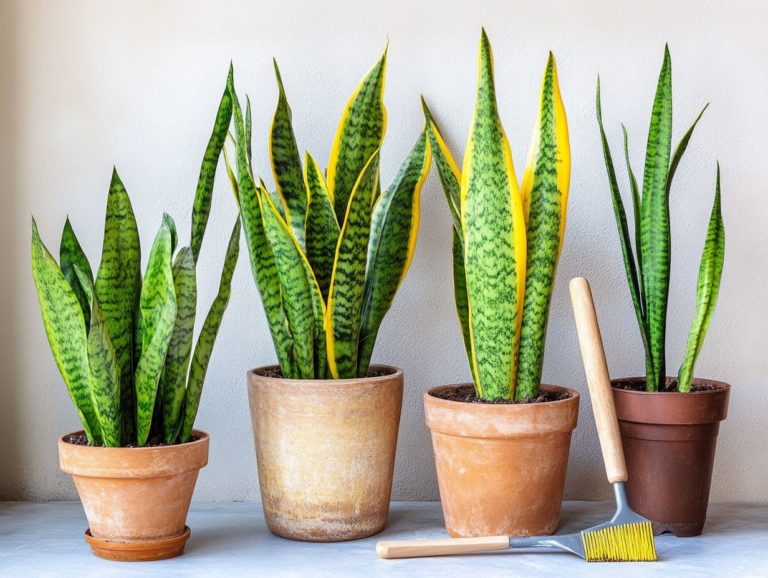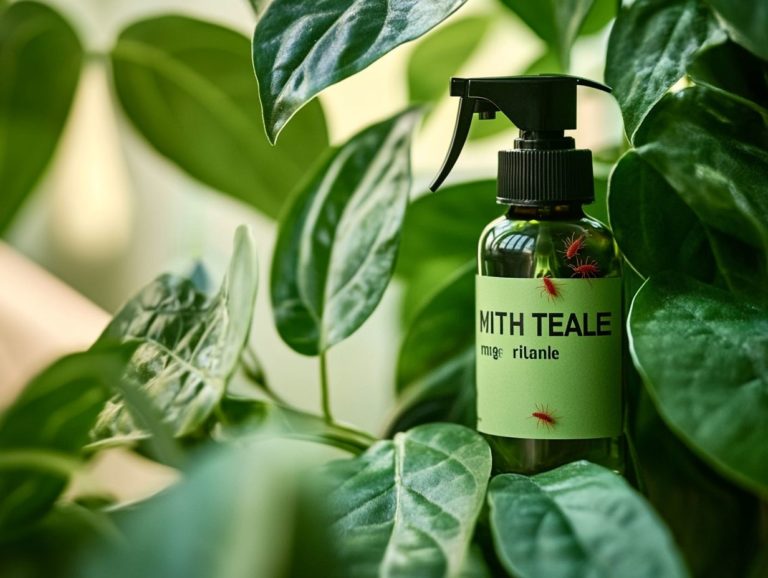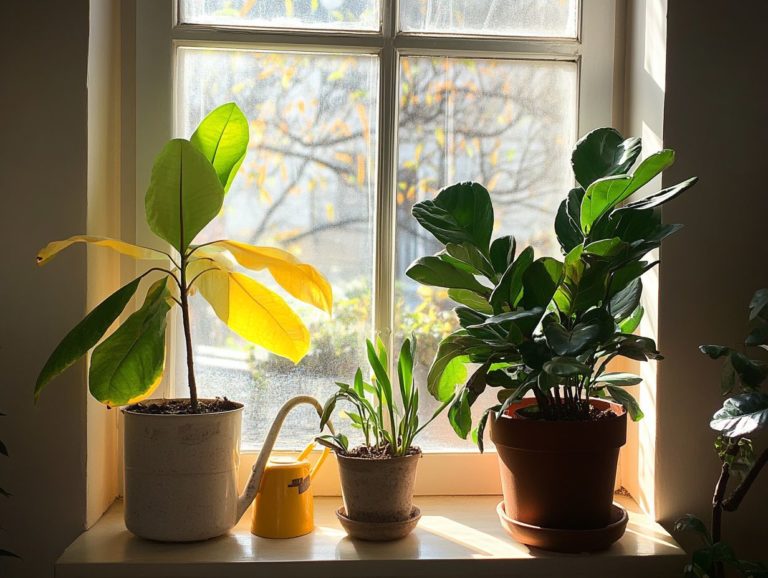Top Causes of Leaf Drop in Houseplants
Houseplants bring life and vibrancy to your home. However, when their leaves begin to drop, it can be disheartening. Understanding the reasons behind this common issue is essential for keeping your plants healthy and thriving.
This article explores the main causes of leaf drop, including overwatering, underwatering, pests, and environmental factors. You’ll discover practical solutions to prevent and tackle these challenges, ensuring your plants remain beautiful and resilient.
Immerse yourself in this guide to learn how to nurture your leafy companions effectively!
Contents
- Key Takeaways:
- 1. Overwatering
- 2. Underwatering
- 3. Lack of Adequate Drainage
- 4. Pests and Diseases
- 5. Temperature Changes
- 6. Poor Lighting
- 7. Nutrient Deficiency
- 8. Root Bound Plants
- 9. Chemical Exposure
- 10. Improper Plant Placement
- 11. Lack of Humidity
- 12. Unsuitable Potting Mix
- 13. Overcrowding of Plants
- 14. Neglect and Lack of Maintenance
- 15. Genetic Factors
- How Can You Prevent Leaf Drop in Houseplants?
- Frequently Asked Questions
- What are the top causes of leaf drop in houseplants?
- How can overwatering lead to leaf drop in houseplants?
- What are some signs of pest infestations that can cause leaf drop in houseplants?
- What can cause root damage in houseplants and how does it lead to leaf drop?
- Can poor lighting really cause leaf drop in houseplants?
- How do temperature fluctuations affect houseplants and result in leaf drop?
Key Takeaways:
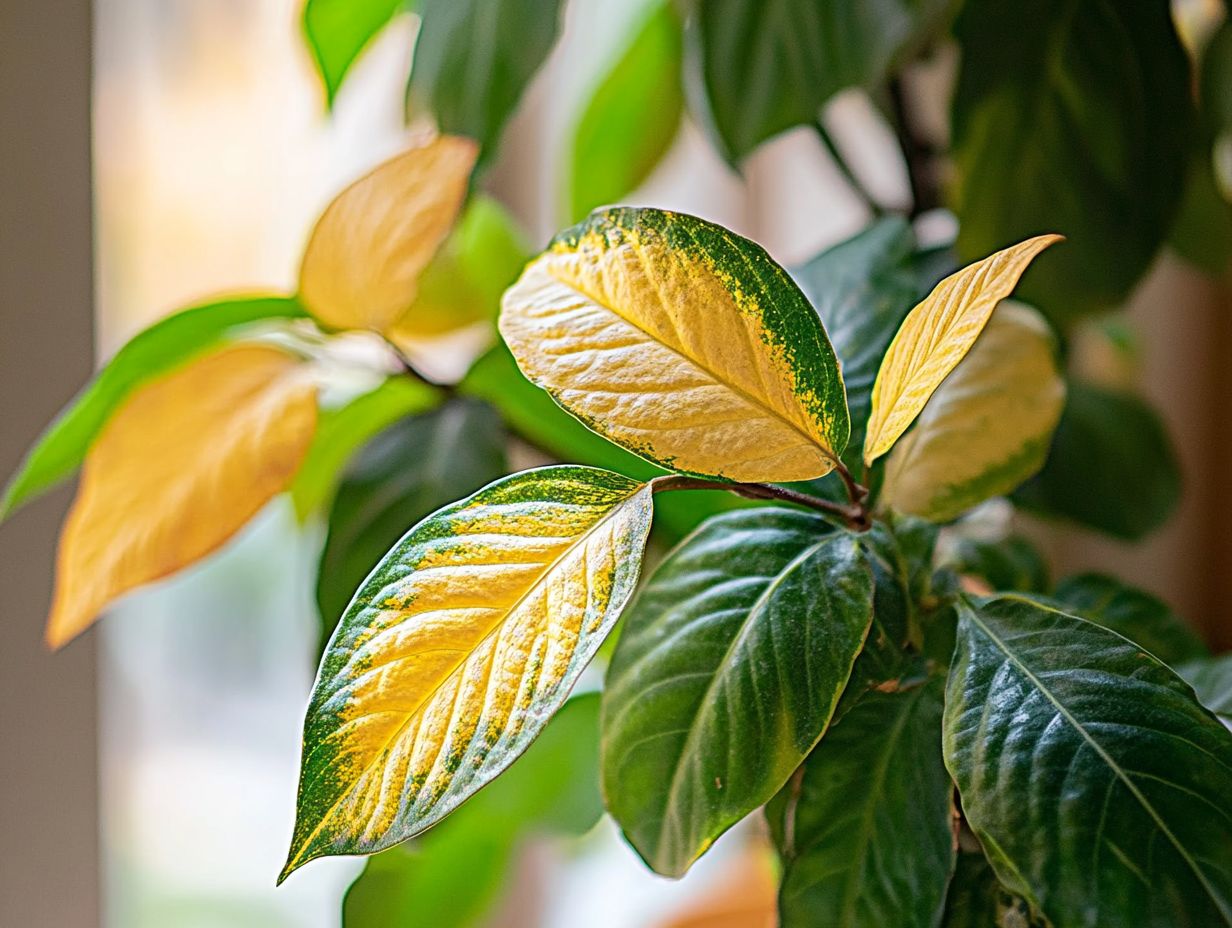
- Overwatering is a leading cause of leaf drop in houseplants, leading to root rot and suffocating the roots.
- Underwatering causes leaf drop by depriving the plant of essential nutrients, resulting in wilting and dryness.
- Proper drainage and a suitable potting mix are vital for preventing leaf drop, allowing for adequate moisture and airflow in the soil.
1. Overwatering
Overwatering is a primary cause of leaf drop in houseplants, leading to a series of negative effects that threaten the vitality of your indoor plants. This issue often arises from misunderstandings about proper watering techniques and the specific needs of different houseplant species.
Recognizing the symptoms of overwatering is vital for preserving your plants’ health and preventing unwanted leaf loss. Signs of overwatering include yellowing leaves, indicating that your plant struggles to absorb nutrients due to overly saturated soil. If you notice mushy or rotting roots, this indicates excessive moisture is impacting their functionality.
Using room temperature water for hydration can significantly benefit your plants since cold water might shock them. It’s crucial to adjust your watering habits based on environmental factors like humidity levels and seasonal changes to give your houseplants the exact amount of water they need to flourish.
2. Underwatering
Underwatering can cause your houseplants to drop leaves. Insufficient moisture disrupts their function and overall well-being. Identifying the symptoms of underwatering early is important to restore your plants’ vitality.
Common signs of underwatering include wilting leaves that appear droopy and lack firmness, along with soil that feels dry to the touch. Establishing a routine to check moisture levels weekly or setting reminders on your phone can help maintain a consistent watering schedule.
Additionally, using humidity trays can significantly benefit your plants by creating a microenvironment that maintains moisture levels. Act now to keep your indoor greenery lush and robust!
3. Lack of Adequate Drainage
A lack of adequate drainage can create trouble for your houseplants, leading to overwatering symptoms that may result in leaf drop and other health problems. Ensure that your pots have proper drainage holes and are filled with a suitable potting mix to keep your plants thriving.
A good potting mix allows excess water to escape and promotes aeration, which is crucial for healthy roots. Regularly check for signs of drainage issues look out for water pooling on the surface or a persistent musty smell around the pot, as these can indicate that your plant roots are sitting in soggy conditions.
To enhance moisture retention without drowning your plants, place a humidity tray filled with pebbles underneath the pots. This clever setup encourages gentle evaporation, providing additional humidity while maintaining proper drainage and fostering robust growth.
4. Pests and Diseases
Insect pests and diseases significantly impact your houseplants, often causing unpleasant leaf loss and harming the health of your indoor garden. Identifying specific pests troubling your plants and applying suitable treatments like insecticidal soap is essential for creating a thriving environment.
Common culprits such as aphids and spider mites are notorious for causing leaf loss. Aphids leave behind a sticky honeydew, which can lead to further complications, while spider mites often make their presence known with tiny webbing.
You might notice symptoms like yellowing leaves or a mottled appearance. To keep these issues at bay, regular monitoring and proper air circulation are crucial. Act now to protect your plants!
When infestations strike, targeted treatments like neem oil or introducing beneficial insects can be highly effective. These methods help your houseplants not just survive but truly flourish.
5. Temperature Changes
Temperature changes can profoundly affect your houseplants, often leading to unpleasant leaf loss as they react to shifts in their environment. These shifts can include excessive heat or chilly drafts. To ensure the well-being of your indoor plants and to prevent stress-induced leaf loss, it s crucial to maintain a stable room temperature.
Most houseplants thrive best in a cozy temperature range of 65 F to 75 F during the day, with a gentle dip at night. When temperatures stray outside this range rising above 85 F or dropping below 60 F your plants may show signs of distress, such as wilting or yellowing leaves.
To combat these extreme conditions, use thermometers to monitor the environment closely. It s wise to position your plants away from heating vents or windows that could expose them to cold drafts. You can also enhance moisture levels in the air with humidity trays, fostering a healthier climate for your plants to thrive.
6. Poor Lighting
Poor lighting is a critical factor that can cause your houseplants to drop leaves. When light levels are insufficient, your plants struggle to photosynthesize, which is the process plants use to turn light into energy. Understanding the specific light requirements of your indoor plants is essential for fostering healthy growth and vibrant foliage.
By assessing light quality and quantity such as intensity, duration, and type you can make informed decisions to enhance your plants’ well-being. Watch for signs of inadequate light; yellowing leaves or leggy growth clearly indicate it’s time for adjustments.
Position your pots near windows for better light exposure, but ensure the light isn t too harsh or too dim. For low-light areas, using grow lights can be a game changer, providing the necessary spectrum to promote photosynthesis and keep your green companions thriving.
7. Nutrient Deficiency
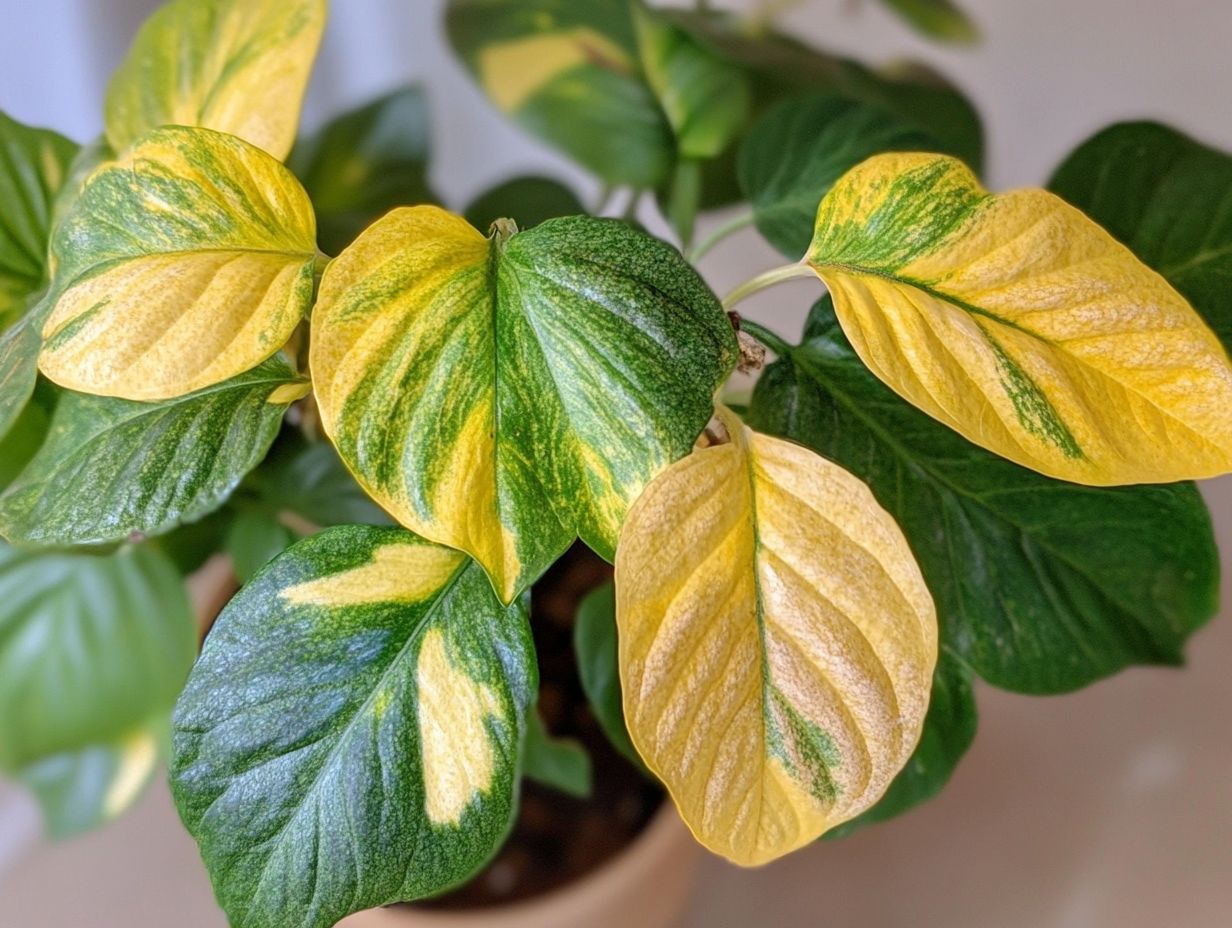
Nutrient deficiency is a common reason behind houseplants dropping leaves. Without essential nutrients, their structure and vitality can become compromised. Implementing a proper fertilization schedule and understanding your indoor plants’ specific needs can effectively prevent nutritional deficits.
As a plant enthusiast, you might notice signs like yellowing leaves or stunted growth clear indicators that your plant is not thriving as it should. Identifying these symptoms early can make all the difference in bringing your plants back to life.
When choosing fertilizers, select one specifically formulated for the type of plant you have. Consider factors like growth stage and environmental conditions. A helpful rule of thumb is to fertilize every 4-6 weeks during the growing season and reduce the frequency during dormancy. This strategy ensures your plants receive a balanced supply of nutrients, fostering lush foliage and robust growth.
8. Root Bound Plants
Seeing houseplants lose leaves often indicates they are root-bound. Their growth is restricted by limited space within the pot, which can cause stress, like when plants are moved to a new pot.
To determine if a plant is root-bound, look for several signs:
- Roots emerging from drainage holes
- Tightly packed roots swirling around the root ball
- Stunted growth despite diligent care
When repotting, gently remove the plant from its pot. Prune any circling roots to promote better growth in the new soil. Choose a pot that s one size larger and fill it with fresh, well-draining soil. This will encourage healthy root growth while maintaining proper watering habits to prevent leaf drop. Follow these best practices to ensure your indoor oasis thrives.
9. Chemical Exposure
Harmful chemicals can cause houseplants to lose leaves due to toxicity or related diseases. It s crucial to understand the risks associated with chemical exposure and choose safe alternatives for pest treatment and fertilization.
Common household substances, like certain cleaning products and pesticides, can harm your indoor plants, leading to yellowing or leaf loss. These chemicals often disrupt the delicate balance of plant nutrients, causing stress and reduced vitality.
You can opt for natural insecticidal soaps, diatomaceous earth, and neem oil as safer pest control alternatives. Incorporating organic fertilizers and using environmentally friendly cleaning agents will help create a thriving indoor garden while minimizing your chemical footprint.
10. Improper Plant Placement
Improper plant placement can lead to frustrating leaf drop from insufficient light or chilly drafts. Optimal positioning in your indoor garden is essential for plant health and growth.
To find the best spots for your houseplants, consider light exposure, temperature, and humidity levels. Many plants thrive in bright, indirect light, while others prefer low-light conditions. Understanding these needs is crucial. Monitor temperature fluctuations to prevent stress on sensitive species. For example, keep tropical plants away from icy windows.
Humidity also plays a vital role. Use humidity trays filled with pebbles and water to create a beneficial microclimate. This not only boosts humidity but also adds a touch of elegance to your indoor greenery.
11. Lack of Humidity
Low humidity can cause houseplants to drop leaves. Many indoor plants thrive in environments with higher moisture levels. Implementing strategies to increase humidity, such as using a humidity tray, can greatly enhance the health of your plants.
Plants like ferns, peace lilies, and tropical varieties come from naturally humid habitats, making them sensitive to dry air. When humidity levels drop, these plants struggle to absorb moisture, leading to stress and issues like leaf browning and wilting.
Group your plants together to create a microclimate with moister air. A room humidifier can elevate moisture levels, ensuring your indoor greenery thrives. A quick misting provides an instant boost to prevent dehydration.
Take the first step today to ensure your plants thrive!
12. Unsuitable Potting Mix
An unsuitable potting mix can significantly impact your houseplants, potentially leading to unsightly leaf drop due to inadequate drainage and nutrient availability. Choosing the right potting mix is essential for creating a cozy home for your plants.
Different houseplants have unique requirements. For instance, succulents flourish in a well-draining mix, while tropical plants thrive in a denser, moisture-retaining medium. It’s crucial to evaluate each plant s specific needs when selecting or creating your potting mix.
A thoughtfully crafted blend of ingredients like peat, perlite, and compost can optimize both drainage and nutrient retention. Always consider the water retention characteristics and the mix’s drying rate, as these factors can help prevent root rot a condition where roots suffocate due to excess moisture while ensuring your plants have easy access to vital nutrients.
With properly amended soil, you can expect lush foliage and vibrant blooms, transforming your space into a thriving oasis. Take action to choose the right potting mix today!
13. Overcrowding of Plants
Overcrowding your plants can lead to unwanted leaf drop as they compete for light, water, and nutrients, causing unnecessary stress. Proper spacing in your indoor garden is essential for nurturing each plant’s health.
When plants are crammed together, they not only compete for vital resources but also create a breeding ground for pests and diseases. This lack of air circulation fosters damp conditions that invite mold and mildew, jeopardizing plant health.
To avoid these pitfalls, adhere to spacing guidelines, ideally positioning your plants a few inches apart based on their size and growth habits. A well-structured indoor garden allows each plant to thrive, enhancing their ability to absorb light and nutrients, ultimately leading to a more vibrant and flourishing arrangement. Don t delay; give your plants the space they need!
14. Neglect and Lack of Maintenance
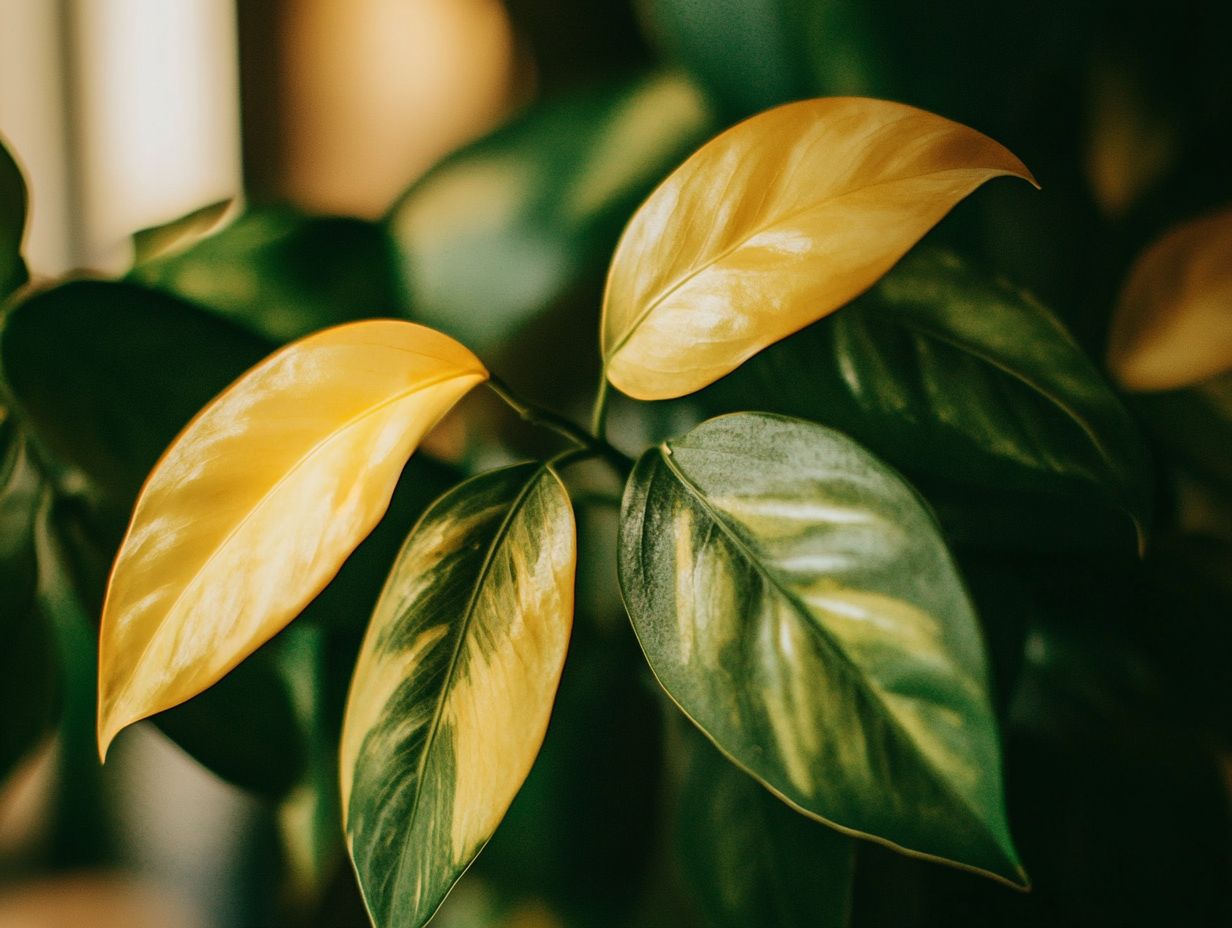
You must consistently care for your plants to keep them healthy! Neglect and lack of maintenance often lead to leaf shedding. Establishing a regular maintenance routine is crucial for keeping your plants flourishing.
This routine involves more than just watering and fertilizing. Regularly check for pests and diseases that could undermine their wellbeing. By weaving these tasks into your weekly or monthly schedule, you can effortlessly monitor plant health without feeling overwhelmed.
For example, designate a specific day each week for watering. This ensures your plants stay hydrated while also creating a consistent opportunity to inspect leaves for any signs of trouble. Utilizing a calendar or an app can be a handy reminder for fertilizing every few months, while tracking pest inspections helps maintain a pest-free haven. Taking care of your plants can turn your home into a lush paradise!
15. Genetic Factors
Genetic factors significantly influence whether your houseplants drop leaves, with certain varieties inherently more prone to leaf loss. By understanding these genetic tendencies, you can make informed choices about which plants to welcome into your indoor garden.
Take the Snake Plant and ZZ Plant, for example. These species are celebrated for their hardiness and resilience, thriving even when conditions aren t perfect. Their genetic makeup allows them to store water and tolerate low light, reducing the chances of leaf drop. In contrast, more delicate varieties often require specific care to keep their foliage lush.
By opting for resilient houseplants like the Pothos or Spider Plant, you can effectively minimize the challenges of leaf loss, which can often arise from various factors. To learn more about this issue, check out what causes leaf drop in indoor plants while creating a vibrant indoor atmosphere. Choose wisely and enjoy a thriving indoor space!
How Can You Prevent Leaf Drop in Houseplants?
Preventing leaf drop in your houseplants starts with a keen understanding of the various factors involved, such as environmental changes, watering practices, and effective care techniques. By creating a nurturing environment and proactively addressing common challenges, you can keep your houseplants thriving and reduce leaf loss.
Pay close attention to the unique needs of each plant. Adjust their care in response to seasonal shifts and ensure they receive just the right amount of water. Establishing a regular watering schedule is crucial, as both overwatering and underwatering can induce stress that leads to leaf drop.
Monitor humidity levels, especially in dry indoor conditions, since many plants flourish in more humid environments. Implement effective pest control measures to tackle infestations early and prevent unhealthy foliage. Consistently check for signs of distress or changes in your plants to intervene promptly, fostering robust growth and vibrant greenery.
What Are the Signs of Overwatering and Underwatering?
Look for signs of overwatering and underwatering to maintain the vitality of your houseplants. These issues can lead to leaf drop and overall decline. Understanding the differences between symptoms of overwatering and those of underwatering enables you to take prompt and effective action.
Overwatering typically shows through yellowing leaves and a bad smell coming from the soil. You may also notice a soggy texture that s hard to miss. In contrast, underwatering manifests as crispy, brown leaf edges and soil that feels excessively dry, sometimes even cracking under pressure.
To tackle these concerns, check your watering practices closely. Start by checking the top inch of soil; if it s dry, quench your plant s thirst. Ensure that your pots have proper drainage to avoid any situation where water sits at the bottom, which can worsen the problem.
By tailoring your watering schedule to meet the specific needs of each plant, you ll create a flourishing environment that promotes their growth and well-being.
How Can You Treat Pests and Diseases in Houseplants?
Effectively treating pests and diseases in your houseplants is crucial for preventing leaf drop and ensuring the longevity of your indoor greenery. Use pest treatment methods like insecticidal soap to combat various insect pests and maintain your plants’ health.
Aside from insecticidal soap, consider options like neem oil and diatomaceous earth, which are gentler on beneficial insects. While chemical treatments are also available, apply them with caution to avoid negative consequences.
Preventive strategies are key. Maintain proper humidity levels, ensure good air circulation, and regularly inspect your plants to significantly decrease the chances of infestations.
By cultivating a healthy environment and employing the right pest control methods, you can enjoy vibrant greenery while safeguarding your plants from potential threats.
What Are the Ideal Temperature and Lighting Conditions for Houseplants?
Understanding the ideal temperature and lighting conditions for your houseplants is essential for cultivating a thriving indoor garden and preventing leaf drop. Each variety of houseplant has specific needs. Meeting those requirements ensures that your plants remain healthy and vibrant.
Tropical plants typically flourish in warmer temperatures, ranging from 65 to 80 degrees Fahrenheit. In contrast, succulents tend to prefer slightly cooler climates, ideally between 60 and 75 degrees.
Light levels also play a crucial role. Some plants thrive under direct sunlight, while others do better in indirect light or partial shade to prevent leaf scorch. Recognizing these preferences allows you to make necessary adjustments in their care.
If you notice a plant showing signs of stress, like wilting or yellowing leaves, it might be time to reposition it or tweak the temperature in its environment, providing the vital support needed for optimal growth.
What Are the Essential Nutrients for Healthy Houseplants?
Essential nutrients are fundamental to the health of your houseplants. Deficiencies can lead to a range of issues, including unsightly leaf drop. By understanding what nutrients your indoor plants require and how to provide them with the right fertilizer, you can ensure vibrant, thriving growth.
Nitrogen is your go-to for promoting lush foliage and overall plant vigor. Phosphorus plays a pivotal role in supporting root development and flowering. Potassium is vital for regulating water and resisting diseases.
When selecting the right fertilizer, consider the specific needs of your plants. Some may need more of certain nutrients than others. Organic options, like compost or fish emulsion, are great choices that your plants will love! As you apply the fertilizer, be sure to follow the recommended dosage on the product label to avoid giving too much fertilizer.
It’s often better to underfeed your plants than to overfeed them, especially during their initial growth stages.
Frequently Asked Questions
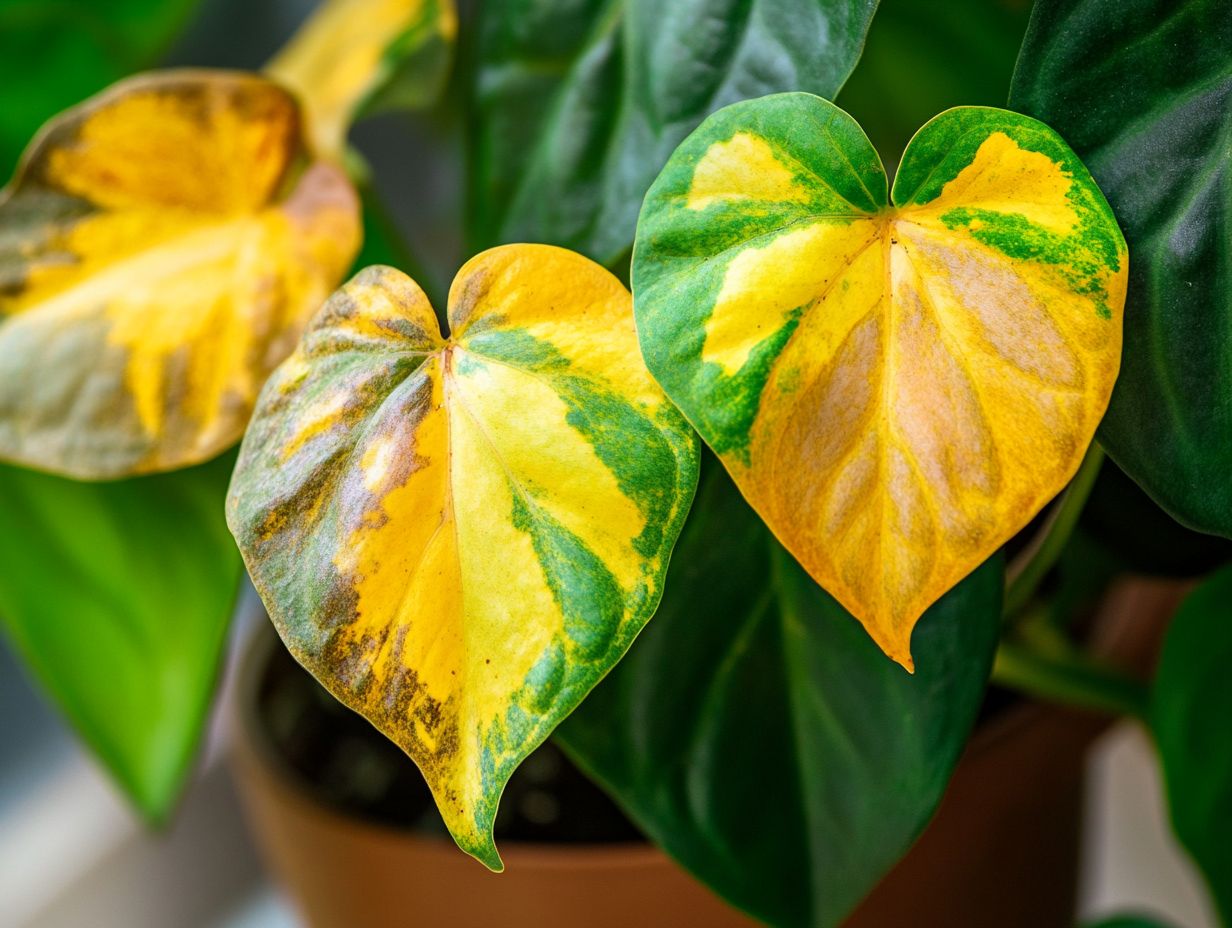
What are the top causes of leaf drop in houseplants?
The top causes of leaf drop in houseplants include overwatering, underwatering, pest infestations, root damage, poor lighting, and temperature fluctuations.
How can overwatering lead to leaf drop in houseplants?
Overwatering can cause the roots of a houseplant to become waterlogged. This can lead to root rot, preventing the roots from absorbing necessary nutrients and causing the plant to shed its leaves.
What are some signs of pest infestations that can cause leaf drop in houseplants?
Common signs of pest infestations include yellowing leaves, sticky residue on leaves or stems, and visible bugs or eggs on the plant. Pests like spider mites, mealybugs, and aphids can all cause leaf drop.
What can cause root damage in houseplants and how does it lead to leaf drop?
Root damage can result from repotting, improper watering, or physical damage. When the roots are damaged, they cannot absorb water and nutrients effectively, which can lead to leaf drop.
Can poor lighting really cause leaf drop in houseplants?
Yes, poor lighting can contribute to leaf drop in houseplants. Plants need light for photosynthesis, which is how they create energy. Without enough light, a plant cannot produce enough energy to sustain itself, leading to leaf drop.
How do temperature fluctuations affect houseplants and result in leaf drop?
Temperature fluctuations can shock houseplants, causing them to shed their leaves. Sudden changes in temperature can stress the plant and disrupt its growth. It’s important to keep houseplants in a stable environment with consistent temperatures.
Check your houseplants today to ensure they’re getting the nutrients they need for a vibrant life!



